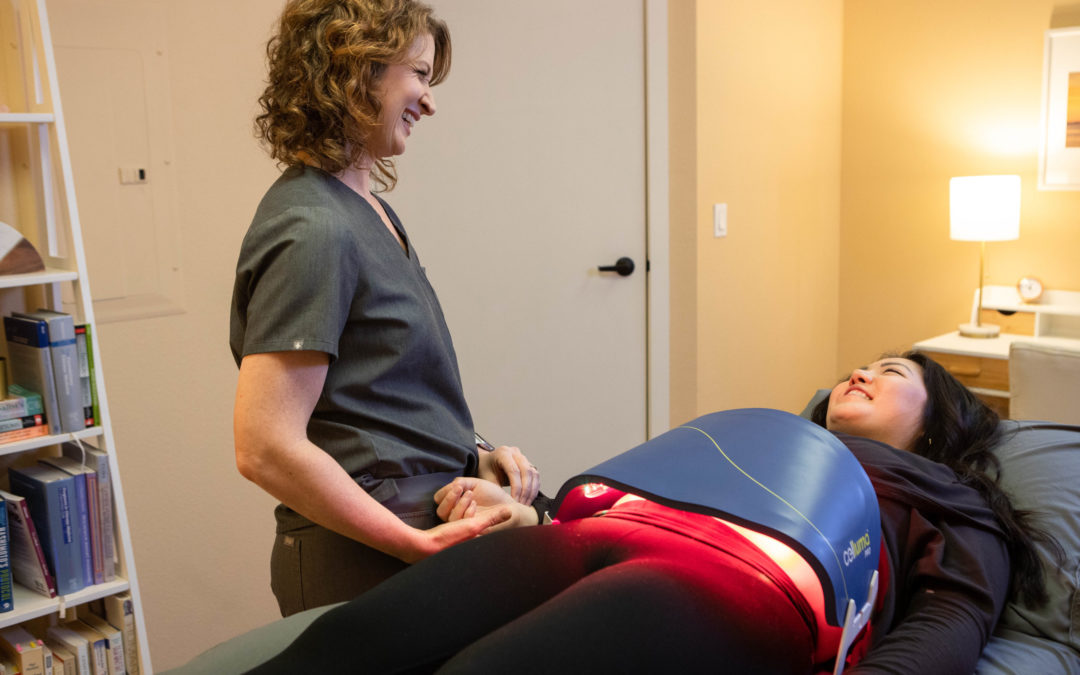Near-Infrared Light Therapy
The science behind red light therapy is rooted in its ability to beneficially stimulate the mitochondria (aka the “powerhouse”) of cells. Celluma, the type of red light therapy we use in our clinic, is an FDA-accepted form of LED phototherapy (aka Low Level Light Therapy or “LLLT”) that stimulate the mitochondria of cells with red light. When exposed to red and near-infrared light, the mitochondria of a cell absorb this energy. This in turn, leads to the production of adenosine triphosphate, or “ATP,” which essentially provides the fuel that cells require to function well. This increase in ATP production fuels cellular metabolism and promotes the regeneration of damaged tissues, leading to a range of therapeutic benefits.
This is significant for reproductive health because the egg cell has nearly 200 times more mitochondria compared to other cells in the body, so it is extremely important that egg cells get high levels of ATP. Unfortunately, as we age, less and less ATP is produced, potentially contributing to a negative impact on the rate of cellular division. Therefore, improved mitochondrial function in egg cells has the potential to optimize the odds of higher egg quality.
Celluma naturally optimizes cellular function to improve cellular health – the cornerstone of reproductive health and fertility.
The benefits of enhanced cellular ATP production include:
- Improved cellular health
- Increased blood circulation
- Decreased muscle tension
- Reduced inflammation
- Softening of scar tissue
- Reduced pain
- Reduce wrinkles and improve skin health
How to Use Infrared Light Therapy for Reproductive Health
Infrared light therapy is best used 2-3x/week for maximum benefit. Your NHRH team will apply the infrared light therapy over the abdomen, neck, back or face depending on therapy goals. The Celluma may be used in conjunction with acupuncture sessions, and a-la-carte between acupuncture sessions.
Please note, infrared light therapy is contraindicated under the following conditions. Please let your NHRH team know BEFORE starting infrared light therapy if you are on, or plan to be on any of these medications, or if any of these contraindications apply to you.
- Pregnant or breastfeeding
- Suffer from seizures or epilepsy.
- Are taking cortisone injections or any steroid injections.
- Are taking any photosensitive drugs (like certain antibiotics).
- Have any known metastasis (Celluma should not be applied locally over known metastasis).
- Have used cosmetic fillers over the area where Celluma is to be applied in the last 5 days.
Infrared light therapy may be resumed 5 days after the final course of contraindicated medications are complete. Those with a history of seizures or epilepsy, and those who are pregnant should not use infrared light therapy.
Research Supporting the use of Infrared Light Therapy
PhotobioModulation for Infertility Grinsted & Hillegass et al, 2019
For four years a group of eight clinics across Denmark and Norway incorporated phototherapy into their treatments during the follicular phase of the menstrual cycle, for a total of six treatments over the span of two weeks.The 239 women total participated in this study, ranging in age from 34-50 years old, had all been trying to conceive but had yet to be successful. After 1-3 months of treatment with LED therapy, however, 158 out of the 239 in the original cohort were able to conceive.
Spitler, R., Ho, H., Norpetlian, F., Kong, X., Jiang, J., Yokomori, K., Andersen, B., Boss, G. R., & Berns, M. W. (2015). Combination of low level light therapy and Nitrosyl-COBINAMIDE accelerates wound healing. Journal of Biomedical Optics, 20(5), 051022. https://doi.org/10.1117/1.jbo.20.5.051022
In this study low level light therapy and nitrosyl cobinamid (NO-Cbi) were combined with the effort of improving wound healing. While the exact mechanism of their combined success is not fully known, it is apparent that the two in combination are able to further activate the electron-transport chain to produce high levels of ATP. There is also an increased activation rate of ERK1/2, which is a protein vital to wound healing. Therefore, wound healing is rapidly accelerated when patients are treated with these two therapies in tandem by increasing ATP.
Mandel, A., & Hamblin, M. R. (2012). A renaissance in low-level laser (light) therapy – LLLT. Photonics & Lasers in Medicine, 1(4). https://doi.org/10.1515/plm-2012-0044
Not only can LED light therapy be used to improve reproductive health, it has countless dermatological and cosmetic benefits as well due to its impressive wound-healing improvements. In fact, in patients treated with LED light therapy, researches noticed an increase in collagen, which is the fibrous protein responsible for holding the skin together, which is instrumental in wound healing. In this study a great improvement in the healing of scar tissue was noted, which is an especially useful treatment for reproductive health ailments.
Still have questions?
Please do not hesitate to reach out if you have any questions about this exciting new treatment. Call, email, or reach out to your provider the next time you are in office. We are looking forward to hearing from you!


